Captain Cook Hawaii Snorkeling: Dive into Adventure
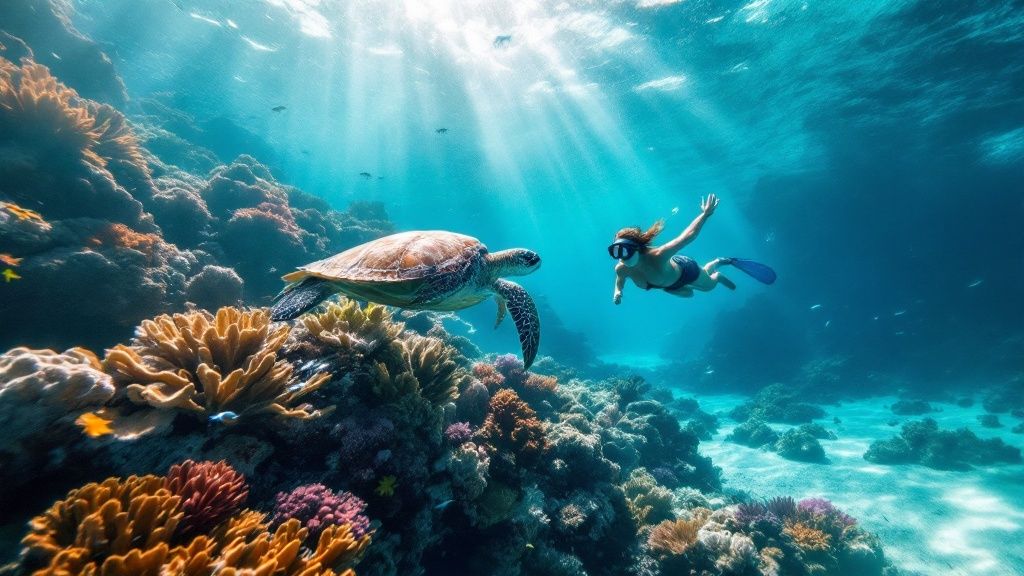
The Rich Legacy Behind Captain Cook Hawaii Snorkeling
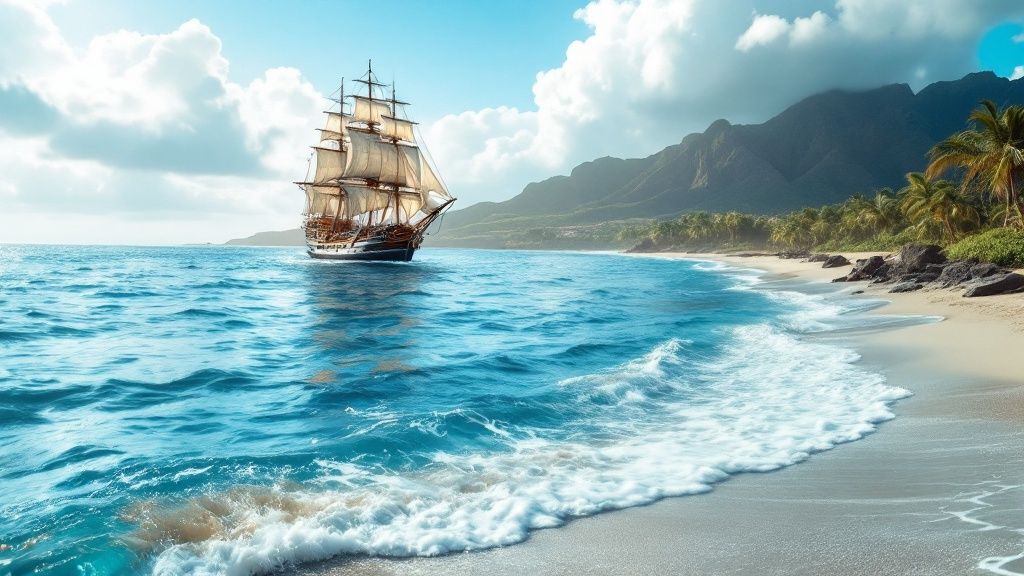
Today, Kealakekua Bay on the Big Island of Hawaii attracts snorkelers worldwide. Its vibrant coral reefs and diverse marine life are a huge draw. But this underwater paradise wasn't always a snorkeling hotspot. The bay's transformation is deeply connected to the legacy of Captain James Cook.
His arrival in 1778 marked a significant turning point. It changed not only Hawaii's future but also how the Western world perceived these Pacific islands. This encounter laid the groundwork for the Captain Cook Hawaii snorkeling experience we enjoy today.
Captain James Cook's 1778 visit marked the first time a Westerner set foot on Hawaiian soil. A momentous occasion in the islands' history. Cook and his crew were initially greeted as gods by the native Hawaiians, due to the timing of their arrival coinciding with the Makahiki season. This initial contact exposed Hawaii to the wider world and ushered in a period of Western influence. To delve deeper into the profound impact of this first encounter, learn more about the first Westerner in Hawaii.
The Impact of Cook's Arrival
Cook's arrival wasn't just a historical event; it directly influenced the marine environment. His naturalists meticulously documented the pristine underwater ecosystem. They provided the first Western records of the very reefs and fish that snorkelers admire today.
These early observations provide a valuable window into Kealakekua Bay's ecological past. They allow us to understand how the bay has changed and what has remained constant over the centuries. Modern snorkelers are essentially retracing the steps of Cook's naturalists, experiencing a comparable sense of wonder and discovery.
Kealakekua Bay: A Living Museum
Kealakekua Bay is more than just a beautiful snorkeling destination; it's a living museum. The bay holds deep historical significance as the site of both Cook's initial welcome and his tragic death.
This duality adds a poignant dimension to the snorkeling experience. Imagine floating above the vibrant coral, knowing this very location witnessed such a dramatic moment in Hawaiian history. The combination of natural beauty and historical significance makes Captain Cook Hawaii snorkeling truly unique.
A Legacy of Conservation
Cook’s legacy extends beyond historical narratives and ecological data. His voyages indirectly contributed to the conservation efforts that safeguard the bay today. The awareness created by Cook's explorations led to the recognition of Kealakekua Bay's ecological importance.
As a result, the bay was designated a Marine Life Conservation District. This designation ensures the ongoing health of the reef and its abundant marine life, making the Captain Cook Hawaii snorkeling experience even more remarkable.
Experiencing History Through Snorkeling
The underwater world of Kealakekua Bay offers more than just colorful fish and coral; it provides a tangible link to the past. By understanding the history of Captain Cook and the impact of his arrival, snorkelers can develop a deeper appreciation for the cultural and ecological significance of this special place.
Every glimpse of a sea turtle or a piece of vibrant coral becomes a connection to a past that continues to shape the present. This makes Captain Cook Hawaii snorkeling an adventure through time as well as an underwater exploration.
Insider Secrets: The Best Captain Cook Snorkeling Spots
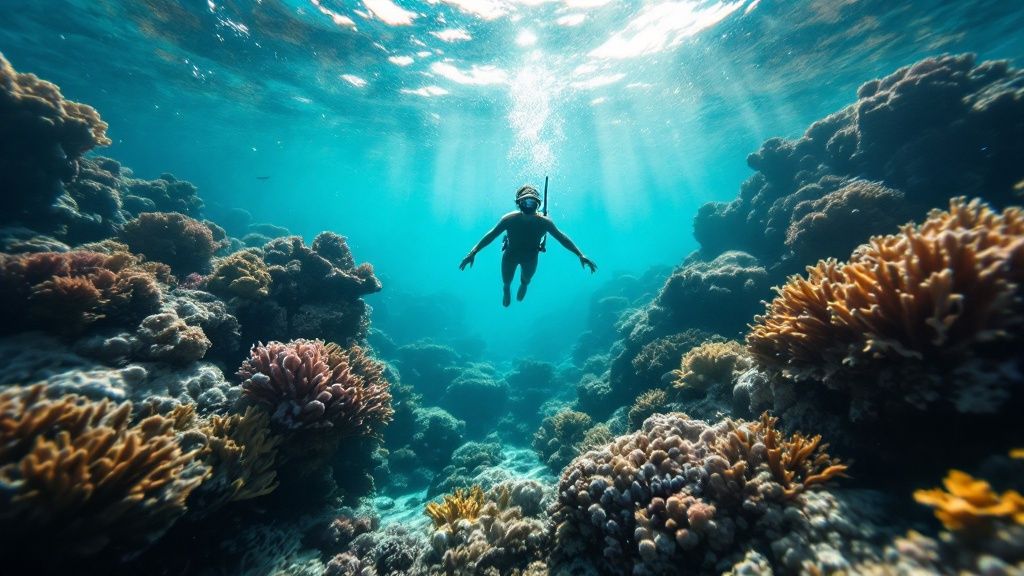
Kealakekua Bay, with its 100-foot visibility, is often the first place that comes to mind when you think about snorkeling in Captain Cook, Hawaii. But this area offers so much more than just one famous spot. Focusing only on the most popular bay might mean missing out on some truly exceptional snorkeling experiences. This guide will reveal some hidden gems and local favorites, promising unforgettable underwater adventures.
Kealakekua Bay: A Snorkeler's Paradise
Kealakekua Bay’s vibrant coral gardens are a major draw, teeming with life. Its protected status as a Marine Life Conservation District ensures a thriving ecosystem. This means you’ll encounter a dazzling array of fish and other marine life. Think colorful reef fish, graceful sea turtles, and maybe even some playful dolphins.
Honaunau Bay: The Two-Step Entry
Honaunau Bay, affectionately known as Two Step, offers a unique entry experience. The lava flows have created a natural staircase into the water, perfect for families and beginners. Be careful, though – those rocks can be slippery! This special spot is known for its calm, clear waters and abundant reef fish.
Pawai Bay: A Secluded Gem
Want a more tranquil escape? Pawai Bay is your answer. Sheltered from strong currents and waves, it provides a peaceful snorkeling experience. It’s ideal for those looking to avoid the crowds and enjoy a quiet connection with nature. The healthy reef ecosystem here attracts a wonderful diversity of marine species.
To help you choose the perfect snorkeling spot for your adventure, we've put together a comparison table highlighting the key features of each location:
To help you choose the perfect spot, take a look at this comparison:
Top Captain Cook Snorkeling Locations Comparison: This table compares the best snorkeling spots in the Captain Cook area by accessibility, marine life diversity, and visitor experience.
| Location | Accessibility | Marine Life Diversity | Best Time to Visit | Facilities | Crowd Level |
|---|---|---|---|---|---|
| Kealakekua Bay | Boat, Kayak, Strenuous Hike | High | Summer | Limited | High |
| Honaunau Bay (Two Step) | Easy shore entry | Moderate | Year-round | Restrooms, limited parking | High |
| Pawai Bay | Boat access | High | Year-round | None | Low |
As you can see, each location offers a unique blend of accessibility, marine life diversity, and visitor experience. Choose the spot that best aligns with your preferences and prepare for an amazing snorkeling adventure!
Timing Your Snorkeling Adventure
Timing is everything! Consider seasonal visibility patterns to maximize your experience. Summer generally offers the best visibility in Kealakekua Bay. Winter can bring the chance to see migrating humpback whales, but the water might be rougher. For more detailed information on planning your trip, check out this activity guide.
Enhancing Your Snorkeling Trip
Understanding entry points and potential hazards is essential for a safe and enjoyable trip. Two Step, while convenient, has those slippery rocks to watch out for. Being aware of current patterns can also help conserve your energy and maximize your underwater exploration time. A little preparation goes a long way in ensuring a worry-free and fully immersive experience.
Face-to-Face With Hawaii's Underwater Residents
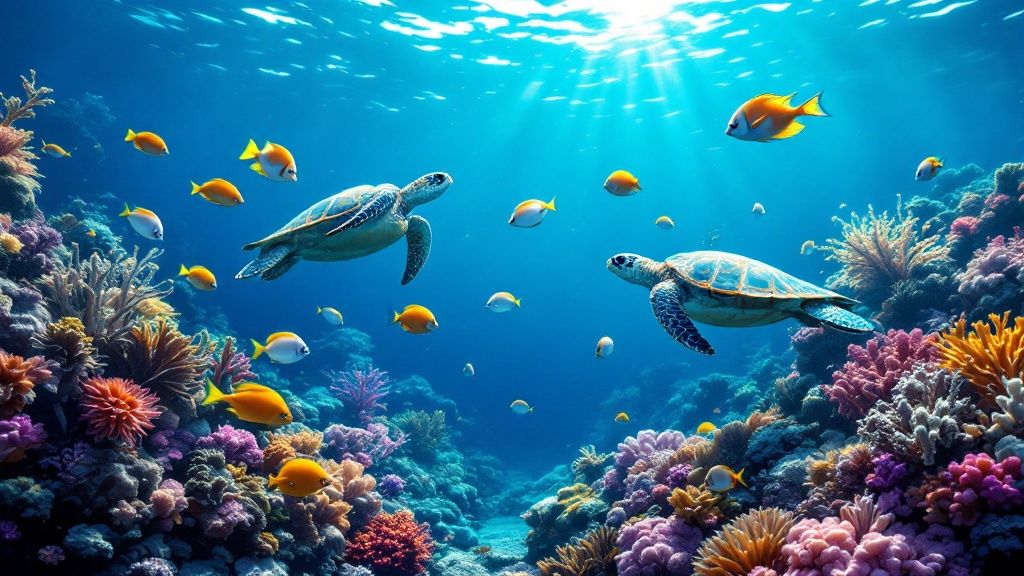
Imagine gliding through the crystal-clear waters of Hawaii, a sea turtle your swimming companion. Picture yourself surrounded by schools of vibrant yellow tangs, their colors a mesmerizing dance in the ocean currents. Captain Cook Hawaii snorkeling offers these incredible underwater encounters and a unique opportunity to connect with Hawaii's diverse marine life.
A Kaleidoscope of Reef Fish
The reefs surrounding Captain Cook are bustling with life. A wide variety of fish, each with its own distinct personality and behavior, call these reefs home. You might spot a Raccoon Butterflyfish, easily identified by its black mask, delicately nibbling at the coral. Or perhaps a Wahoo, a swift predator, will flash past in a blur of silver. Learning about the diverse inhabitants of this underwater world adds another layer of enjoyment to your snorkeling adventure.
Endemic Wonders: Species Found Nowhere Else
Hawaii's isolated location has fostered a remarkable degree of endemism. This means many of the marine species found here exist nowhere else on Earth. The Yellow Tang, a brilliant yellow surgeonfish, is a true Hawaiian icon. Another endemic marvel is the Humuhumunukunukuapua'a (Reef Triggerfish), recognized as Hawaii's state fish. Spotting these unique creatures during your snorkeling trip makes the experience truly special. For more information, check out our full sitemap.
The Coral Ecosystem: Foundation of Life
Coral reefs are often referred to as the "rainforests of the sea" because of their incredible biodiversity. These intricate ecosystems offer food and shelter to countless marine animals. The health of the coral is vital for the entire ecosystem, which in turn, supports the unforgettable snorkeling experiences found in Captain Cook, Hawaii.
This delicate balance, however, has faced significant challenges. Environmental conservation is a critical concern in Hawaii. Following Captain Cook's arrival, introduced species and increased human activity have negatively impacted the native ecosystem. Learn more about Captain Cook’s impact. Today, marine protected areas, encompassing more than 30% of Hawaii's near-shore waters, play a crucial role in preserving Hawaii's marine biodiversity for future generations. This protection safeguards the long-term health of the coral reefs and fish populations, essential for sustaining snorkeling opportunities.
Encounters with Larger Marine Life
Captain Cook snorkeling isn't just about reef fish. Spinner dolphins, known for their playful acrobatics and leaps, are frequent visitors to these waters. Often seen in pods, these dolphins create exciting encounters for snorkelers. Seasonal migrations also bring magnificent humpback whales, adding an element of wonder and awe to the underwater world.
Ethical Snorkeling: Respecting the Underwater World
As we enjoy these amazing underwater experiences, it's essential to practice ethical snorkeling. This involves keeping a respectful distance from marine life, refraining from touching the coral, and using reef-safe sunscreen. These simple acts help protect the fragile ecosystem and ensure the sustainability of Captain Cook Hawaii snorkeling for years to come.
Mastering the Art of Captain Cook Hawaii Snorkeling
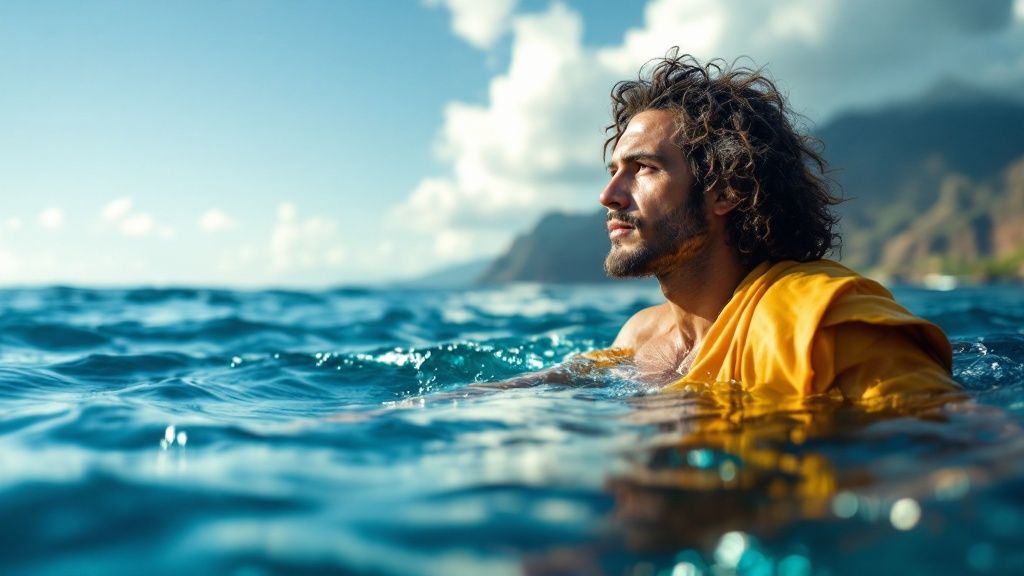
Going from a snorkeling beginner to a confident underwater explorer at Captain Cook, Hawaii takes more than just basic equipment. It requires understanding the environment and learning techniques that experienced snorkelers use. This guide will help you get the most out of your snorkeling adventure at this incredible location.
Essential Gear For Hawaiian Waters
Having the right gear can make all the difference in your snorkeling experience. A mask, snorkel, and fins are the foundation of your equipment. However, specific types of gear are better suited for Hawaiian waters. A low-volume mask, for example, reduces the space between your eyes and the lens, giving you a wider field of vision. A dry-top snorkel prevents water from getting in the tube, especially useful in choppy conditions. Finally, your fins should fit well and propel you efficiently.
Decoding Ocean Currents
Understanding the currents in Kealakekua Bay is essential for saving energy and exploring more of the underwater world. Instead of struggling against the current, enter the water up-current and let it carry you along the reef. Think of it like a relaxing drift down a river, allowing you to observe the underwater scenery effortlessly. This will also prevent exhaustion, giving you more time to enjoy the vibrant coral.
Breathing Techniques For Extended Underwater Time
Mastering proper breathing techniques will help you stay underwater longer. Slow, deep breaths use less air and create a sense of calm. Focus on fully exhaling to get rid of carbon dioxide. This improves oxygen intake and extends your time below the surface. It’s similar to the way scuba divers conserve air.
Timing Your Snorkeling Adventure For Optimal Visibility
The time of day you choose to snorkel can greatly impact visibility and marine life activity. Mornings usually have the clearest water and the best light, making the reef colors even more vibrant. The ideal time is often between 8:00 AM and 10:00 AM. The water tends to be calm and the sunlight is optimal. This is also when many marine species are most active, increasing your chances of some amazing encounters.
Navigating Challenging Entry Points
Some snorkeling spots, such as the famous Two Step at Honaunau Bay, have tricky entry points. The lava rocks can be slippery, even though they form a natural staircase. Enter and exit the water with careful, deliberate steps and a firm grip to avoid falls. Water shoes can provide extra traction and protect your feet from sharp rocks.
Snorkeling Equipment Checklist
Before heading out, it’s a good idea to review a checklist to make sure you have everything you need for a safe and enjoyable experience. The table below provides recommendations for snorkelers of all levels, along with cost estimates and places to buy or rent.
| Equipment | Beginner | Intermediate | Advanced | Where to Rent/Buy | Estimated Cost |
|---|---|---|---|---|---|
| Mask | Essential | Essential | Essential | Snorkel shops, online retailers | $20 – $100 |
| Snorkel | Essential | Essential | Essential | Snorkel shops, online retailers | $15 – $50 |
| Fins | Essential | Essential | Essential | Snorkel shops, online retailers | $20 – $80 |
| Rash Guard | Recommended | Recommended | Recommended | Surf shops, online retailers | $25 – $50 |
| Reef-Safe Sunscreen | Essential | Essential | Essential | Pharmacies, online retailers | $10 – $20 |
| Waterproof Camera | Optional | Recommended | Recommended | Electronics stores, online retailers | $50 – $500+ |
| Underwater Housing | N/A | Optional | Recommended | Camera stores, online retailers | $30 – $300+ |
By following these tips and planning ahead, your Captain Cook snorkeling adventure will be both safe and memorable. You'll be able to truly appreciate the underwater world, connect with the marine life, and create lasting memories. For a guided tour that combines history and expert snorkeling instruction, consider booking an excursion with Kona Snorkel Trips. They provide personalized trips for all skill levels, guaranteeing an unforgettable experience in Kealakekua Bay.
Sacred Waters: The Cultural Soul of Captain Cook
Hawaii's vibrant coral reefs and diverse marine life offer a captivating snorkeling experience. But beyond the visual beauty lies a deeper significance: the cultural importance of these waters for Native Hawaiians. Their centuries-old relationship with the ocean is built on deep respect and a profound sense of interconnectedness, offering a unique perspective that enriches any snorkeling adventure.
Ahupua'a: A Sustainable System
At the heart of this relationship is the ahupua'a, a traditional land management system. Extending from the mountains to the sea, each ahupua'a encompassed all resources within its boundaries. This holistic approach ensured sustainable resource management, protecting the reefs and marine life across generations. It also highlighted the interconnectedness of land and sea, reflecting a profound understanding of ecological balance.
Underwater Stories and Landmarks
Beneath the surface, many underwater landmarks hold significant cultural meaning for Native Hawaiians. Often linked to ancient legends and beliefs, these sites add a layer of historical depth to any snorkeling experience. For example, specific rock formations might be associated with deities or depict important events in Hawaiian mythology. Knowing these stories transforms an underwater exploration into a journey through time and culture.
When Captain Cook arrived in Hawaii, he estimated the native population to be between 350,000 and 400,000 people, a figure still debated among historians. The arrival of outsiders, however, brought significant changes. Sadly, diseases introduced by foreigners contributed to a decline in the native population, marking a turning point in Hawaiian history. Today, snorkeling in these waters offers not only a glimpse into a thriving ecosystem but also a poignant reflection on the cultural interactions that have shaped these islands. To delve deeper into this historical period, you can explore more here. For further information on our website, please refer to our sitemap.
The Spiritual Significance of Marine Life
Beyond the physical landscape, certain marine species hold deep spiritual significance in Hawaiian culture. The honu (sea turtle), for instance, often symbolizes good luck and longevity. The mano (shark) can represent guardianship and protection. Recognizing these cultural associations adds another dimension to observing marine life, fostering a deeper appreciation for Hawaiian traditions.
Modern Conservation Meets Traditional Wisdom
Modern conservation efforts in Hawaii increasingly draw upon traditional Hawaiian wisdom. The principles of ahupua'a, for instance, are being incorporated into contemporary resource management strategies. This integration acknowledges the value of ancestral knowledge in tackling current environmental challenges. It also emphasizes the importance of community involvement in preserving both natural and cultural heritage.
Supporting Local Communities Through Responsible Snorkeling
Visitors can play an active role in supporting local communities and their efforts to protect these sacred waters by embracing responsible snorkeling practices. This includes showing respect for cultural sites, supporting local businesses, and choosing tour operators committed to sustainable tourism. This thoughtful approach ensures that the benefits of tourism reach beyond individual experiences and contribute to the long-term preservation of Hawaii’s unique cultural and natural treasures.
Your Captain Cook Snorkeling Adventure Blueprint
Planning a Captain Cook snorkeling adventure in Hawaii requires more than just throwing a swimsuit in a bag. It takes a detailed plan to ensure a smooth, enriching, and unforgettable experience. This guide, incorporating tips from locals and seasoned snorkelers, will help you navigate each planning step.
Choosing Your Ideal Accommodations
Your choice of lodging can significantly impact your snorkeling experience. Some hotels and resorts offer direct access to prime snorkeling locations, eliminating long travel times. Others provide snorkel gear rentals and storage, removing the hassle of transporting equipment. Consider factors like proximity to Kealakekua Bay, Honaunau Bay, or Pawai Bay, as well as amenities like on-site dive shops and boat tours.
Transportation: Getting to the Best Spots
Getting around the Big Island to reach your snorkeling destinations requires planning. Shuttle services provide a stress-free way to reach Kealakekua Bay, while rental vehicles offer more flexibility to explore various locations. If you choose a rental car, make sure it has enough room for snorkel gear. Some rental companies even offer vehicles specifically outfitted for outdoor adventures.
Guided Tours vs. Independent Exploration
Choosing between a guided tour and independent snorkeling involves weighing several factors. Guided tours provide expert local guides who can highlight hidden gems and share insights about the marine environment. They also handle logistics like transportation and equipment. Independent exploration, conversely, offers greater freedom to explore at your own pace and discover secluded areas. Consider your experience level, budget, and desired level of interaction to make the right choice.
Seasonal Considerations for Optimal Snorkeling
Hawaii's climate and marine life change throughout the year, affecting your snorkeling experience. Summer generally offers calm waters and excellent visibility, perfect for viewing the vibrant coral reefs. Winter, while potentially offering glimpses of migrating humpback whales, can have rougher seas and lower visibility. Knowing these seasonal patterns helps you plan your trip for the best snorkeling conditions.
Permits and Regulations: Protecting Sacred Waters
Kealakekua Bay, a historically and culturally significant site, has specific regulations. Securing the necessary permits for accessing conservation areas ensures you're following local laws and contributing to preserving this special place. Also, learn the rules regarding marine life interaction, such as keeping a respectful distance from sea turtles and not touching coral, which demonstrates responsible snorkeling practices.
Packing Essentials: Comfort In and Out of the Water
Packing for your snorkeling trip requires more than just beach attire. Essentials include reef-safe sunscreen to protect both your skin and the coral, a rash guard for extra sun protection and warmth, and water shoes for navigating rocky entries. A waterproof camera helps capture your underwater adventures, while a dry bag protects your valuables.
Structuring Multiple Snorkeling Days
If you're snorkeling multiple days, strategic planning is essential to avoid fatigue and maximize enjoyment. Vary your locations to experience diverse marine environments, from the active reefs of Kealakekua Bay to the quieter waters of Pawai Bay. Include rest days or other activities like hiking or experiencing local culture to avoid overexertion and enjoy the Big Island's many offerings.
Avoiding the Crowds: Timing Your Visits
Captain Cook snorkeling sites can become crowded, especially during peak season and when cruise ships are docked. Check cruise ship schedules and plan your visits to avoid busy times and enjoy a more peaceful experience. Arriving early often means calmer waters and fewer people.
For an exceptional snorkeling adventure combining expert guidance, historical context, and environmental responsibility, book your next Captain Cook snorkeling tour with Kona Snorkel Trips. They provide personalized excursions for all skill levels, promising an unforgettable experience in Kealakekua Bay and beyond.
